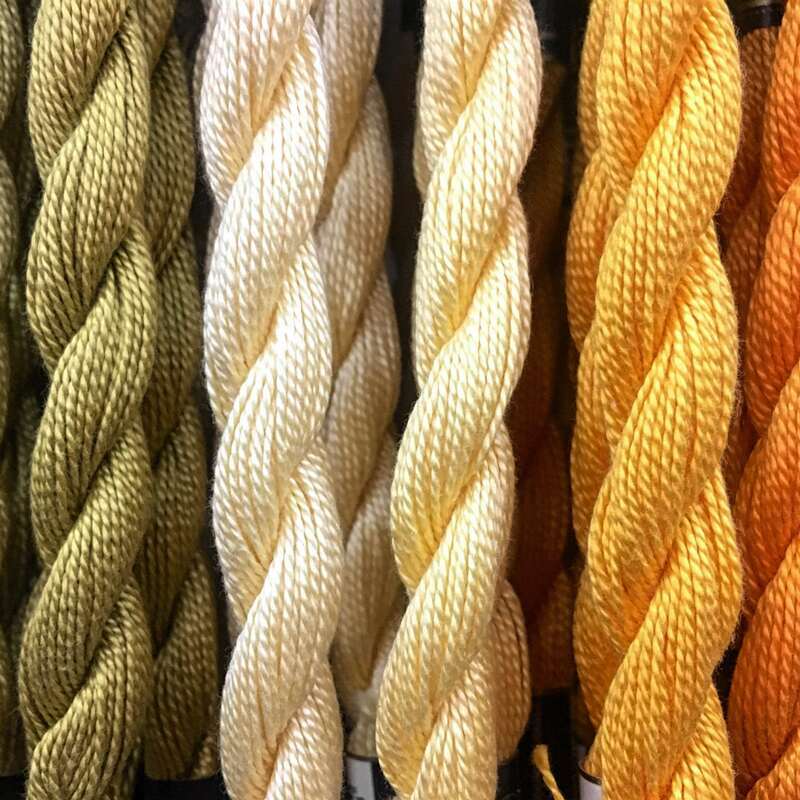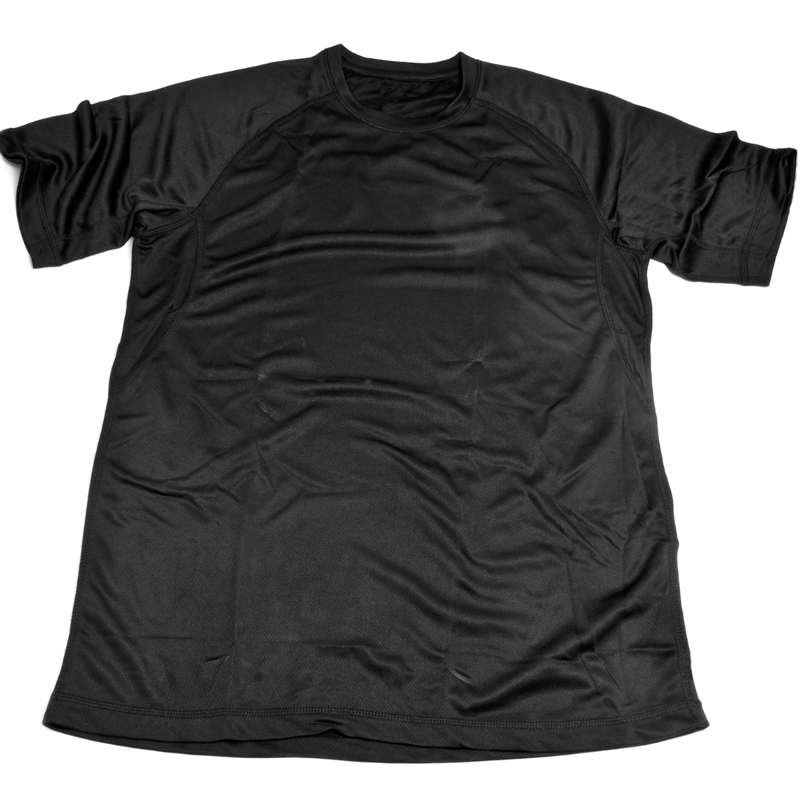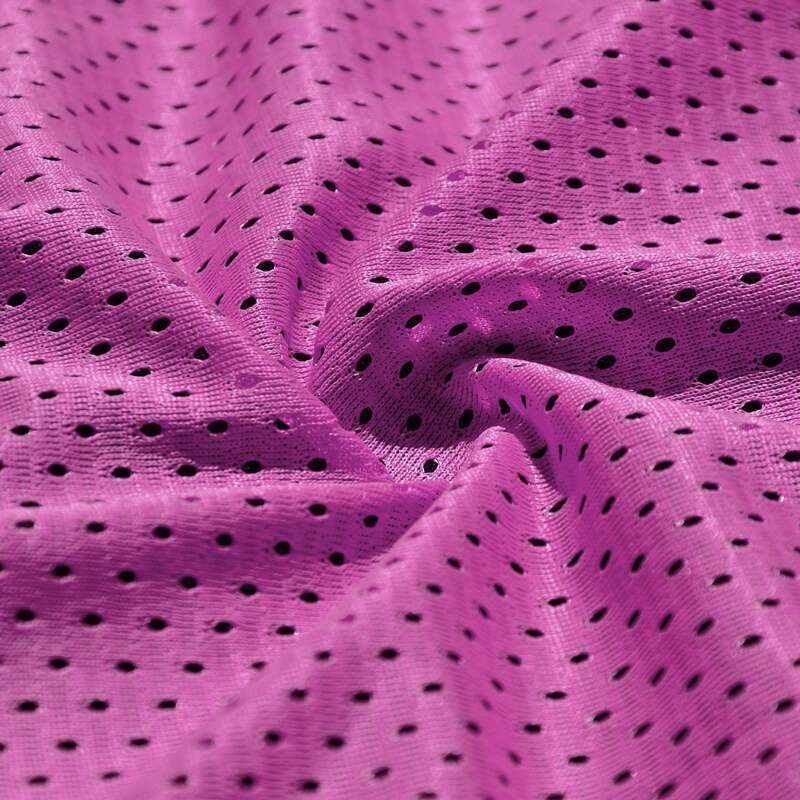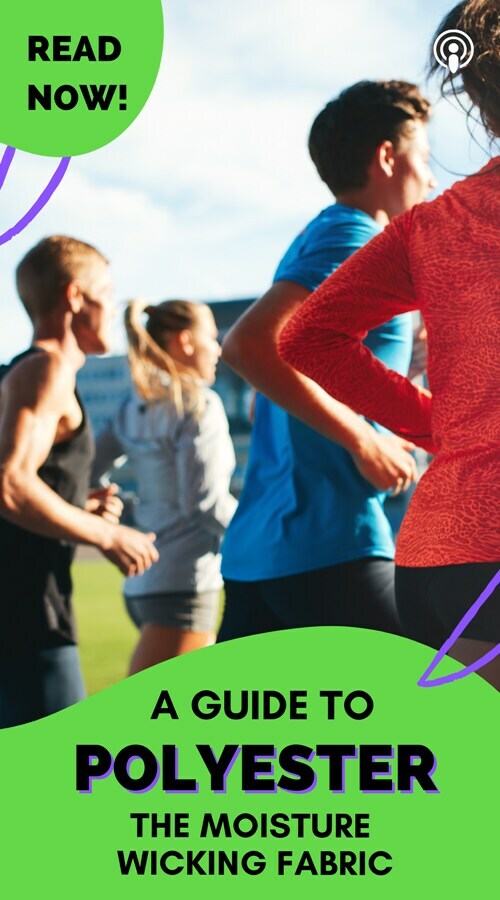
A Guide to Polyester: The Moisture-Wicking Fabric
By ShirtSpace | Dec 21, 2020 | Updated Aug 15, 2023Polyester is a popular and well-known moisture material because of its moisture-wicking fabric. Moisture-wicking means that sweat, rain and other liquids do not absorb directly into the shirt, thus making this material able to dry out quickly. Polyester is the best moisture-wicking fabric because of its ability to draw moisture away from the body.
Unlike cotton, which generally absorbs all the liquid, polyester wicks the liquid in the first layer of material so that you don’t feel it on your skin. Because your sweat is distributed among the first layer of fabric, this allows the moisture wicking material to breathe and your sweat to evaporate quickly. Polyester is a great moisture-wicking fabric and makes a perfect option for those looking for athletic wear or to supply a sports team with team uniforms and jackets to use during practice or games. Staying dry is really important as an athlete because not only is it more sanitary, but it is also healthier, so you don’t catch a cold while sweating outside in low temperatures.
At ShirtSpace we carry bulk polyester t shirts, wholesale polyester hoodies, polyester sweatshirts and moisture-wicking athletic apparel to print designs for your t-shirt selling business or client's sports team. With affordable and wholesale options for polyester apparel that is wicking fabric, it doesn't get much better than that! Our goal at ShirtSpace is to supply the garment decorators of various styles such as screen printing, heat vinyl transfer, sublimation and more with the best products and moisture-wicking fabrics to work with. Your brand is our brand, so start shopping with ShirtSpace for blank, bulk, and wholesale moisture-wicking polyester styles!

What is Moisture-Wicking Polyester Made From?
Polyester is a type of polymer, which is made of long, repeating chains of molecules. Polymers can be used to make plastic, fibers, and material. This explains why polyester fabric in clothing is made up of plastic components. There are a wide range of products that can be made with polyester, including rubber, epoxy and glass. As a clothing material, polyester was first introduced to the general public in 1951. It was marketed as a desirable wicking fabric because of its ability to be worn and washed without any pulls or wrinkling.
Polyester gets its moisture-wicking properties from its makeup caused by a chemical reaction involving petroleum, air, and water. That combination creates polyester, which is the artificial fiber that is composed of purified terephthalic acid (PTA) and monotheluene glycol (MEG).
Because of this chemical makeup, Polyester is not an organically sourced or natural fabric. Instead, polyester is a thermoplastic, which means it can be melted and reformed. When making fibers for things such as polyester ropes or polyester clothing, chemists melt polyester pellets and force the hot liquid through small holes. On the exit side of the holes, the polyester fibers solidify, resulting in yarn, thread or other materials.
The textile process of creating polyester is fascinating, but keep in mind it is not organic. People who are looking for eco-friendly apparel or want to reduce their carbon footprint should look for a different material such as cotton or linen. Because moisture-wicking polyester is a fiber derived from petroleum-based products, it is not considered sustainable nor biodegradable.

The Use of Polyester Fibers in Fabrics
Since polyester is a synthetic material, that makes it the best option for a moisture-wicking fabric.
Polyester fibers can be spun together with natural fibers to produce a blend. This is where industry terms such as cotton/poly and poly/spandex come in to play. Some benefits of cotton-polyester blends are that they provide more durability, reduce shrinking, have moisture wicking fabric , and they wrinkle less. Synthetic fibers such as polyester spandex blends or nylon blended with polyester have high resistance to wind and water, because polyester is moisture-wicking.
Fabrics that are woven together from polyester thread can be used for various different materials types, such as:
Apparel:
-
Shirts
-
Pants
-
Jackets
-
Hats
Home Furnishings:
-
Bedsheets
-
Blankets
-
Upholstered Furniture
-
Computer Mouse Mats
Industrial:
-
Yarns
-
Ropes
-
Fabrics for Conveyor Belts
-
Safety Belts
-
Plastic Reinforcements
Cushioning and Insulating:
-
Pillows
-
Comforters
-
Upholstery

What is Moisture-Wicking and How Does Polyester Fit In?
Moisture-wicking means keeping you dry. Due to its modern technical fabrics, this material will draw moisture away from your body, which then makes it easier to evaporate. Because of these properties, moisture-wicking fabrics are often used in the makeup of polyester or athletic apparel that will be exposed to potential sweat or moisture. This material combines two ways to keep you dry. First, it will quickly move any moisture away from your skin and through the fabric. Then it will dry rapidly, which typically creates a cooling effect. It is purely magic! This magical property of polyester is the cherry on top when it comes to polyester fabrics and what makes them great!.

Moisture-Wicking Fabric for Athletics & Sports Teams
We recommend polyester because it is breathable and great for cool and warm-weather activities. When choosing a polyester garment, you should always consider fabric construction and weight. Moisture-wicking fabric is a good idea year-round because polyester fabric helps you regulate your body heat. Moisture wicking fabric helps you keep warm in the winter and cool in the summer!
Polyester reigns supreme as the best moisture-wicking material, making it perfect for athletes and sports teams to wear as uniforms. Have you ever wondered why all of your workout t-shirts and pants have that soft, buttery and stretchy feel? Well, that is because they are most likely made from moisture-wicking polyester. Printing logos and designs on wholesale polyester t-shirts is popular in the garment decorating industry. Think of all the soccer teams that need uniforms! ShirtSpace is proud to supply you with hundreds of polyester styles, multiple color options, and the best and reputable brands in the blank apparel business.
So there you have it! We wanted to break down the basics when it comes to polyester, as this fabric can be intimidating at first. Using synthetic materials for garment transfers and sublimation is becoming increasingly popular. Not to mention, polyester t-shirts are a great option for sports teams and gym clothing since it is rain and sweat resistant with its moisture-wicking properties. We hope you learned the background and science behind polyester, as well as why it makes for a great material for sublimation and athletic/gym clothing. Shop our selection of blank, bulk, and wholesale polyester styles here.

Sublimation and Polyester: Printing Designs on Polyester Fabric
Sublimation is a garment printing process that uses extreme heat and pressure to bond designs into fabric. When it comes to material makeup for sublimation projects, the higher percentage of polyester the better. Keep in mind that not all 100% polyester t-shirts that are made up of moisture wicking material are a good option for sublimation. You also need to understand that different polyester blends may give different results – during the sublimation process, the ink will only adhere to the polyester and the colors of the image will appear faded. Results may vary, so practice and testing your technique is important!
As for color options, you might be a little limited when it comes to sublimation and polyester t-shirts. You just need to make sure that the ink you are decorating with is darker than the fabric color. Another interesting fact to keep in mind is that there is no white ink for sublimation, because white ink cannot be printed on a colored garment. On the contrary, a white t-shirt is the best option for sublimation printing.
While polyester can be blended with nylon fabric, it is not recommended to use when sublimating apparel. You shouldn’t sublimate on nylon due to its low heat melting threshold – and you don’t want to get injured or ruin your project! Since moisture-wicking polyester fabrics are highly stain-resistant, there is only one type of fabric dye that can be used to change and manipulate the color of polyester fabrics. These are known as disperse dyes. Now that you have this information, you can probably put two and two together. If you’re not that great at math, we can break it down further for you. That means Polyester is NOT a good material to use for tie-dying t-shirts or other dying methods of garment decorating!

Where Can I Buy Polyester Shirts in Bulk?
Luckily, you are in the right place! As educators in the garment decorating industry, we want to provide insights and details into the fabric and apparel manufacturing domain. You can buy moisture-wicking fabric like polyester shirts in bulk at ShirtSpace.com and score the deal you’ve always dreamed of at wholesale and bulk pricing.
The need for bulk apparel is becoming more and more popular as people continue to start small garment decorating businesses. Selling 100% polyester t-shirts and apparel with printed designs is a great way to start a new hobby or business. ShirtSpace provides the blank, bulk apparel at wholesale pricing so small businesses can keep their checks and balances in order. Find cheap, moisture-wicking polyester options across a variety of styles such as t-shirts, sweaters, men's, women's and kid's apparel.
With 100% polyester, polyester blends, and cotton/polyester, we have nearly every material and blend for your creative vision. With endless styles that are fashion-forward or just plain and durable – fit your family, clients or a sports team with moisture-wicking polyester apparel with bulk and wholesale pricing!



Leave a Comment
We take your privacy seriously and will not share or publish your email address.
This site is protected by reCAPTCHA and the Google Privacy Policy and Terms of Service apply.